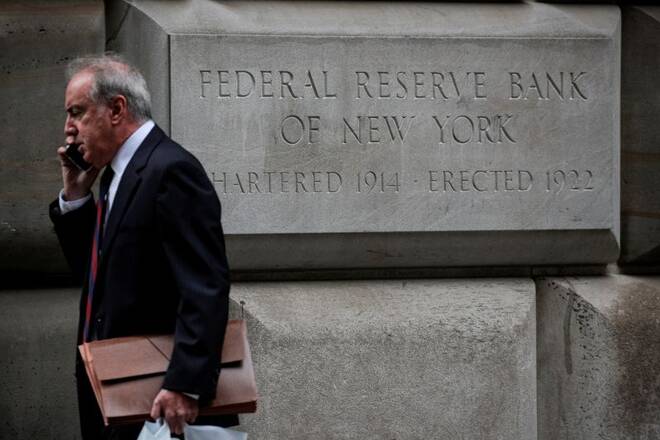Advertisement
Advertisement
NY Fed: Bank liquidity may be tighter than thought, with policy implications
By:
By Michael S. Derby (Reuters) - The way the banking system manages its cash suggests the financial system may not be as flush as many now understand, and that could have implications for how the Federal Reserve manages the size of its balance sheet, a paper from the Federal Reserve Bank of New York said Friday.
By Michael S. Derby
(Reuters) – The way the banking system manages its cash suggests the financial system may not be as flush as many now understand, and that could have implications for how the Federal Reserve manages the size of its balance sheet, a paper from the Federal Reserve Bank of New York said Friday.
That’s because even though institutions like the Fed have flooded the banking system with reserves, many banks continue to manage fast-moving inflows and outflows of cash much like they always have, and that is tightly, the paper said. The authors argue this way of managing cash positions could become an issue for the Fed as it seeks to draw down the size of its holdings of bonds, which reduces the level of bank reserves in the system.
Banks view their daily reserve balance levels as “scarce resource,” the paper’s authors said, adding “even in the era of large central bank balance sheets, rather than funding payments with abundant reserve balances, we show that outgoing payments remain highly sensitive to incoming payments.”
“There is still a potential for strategic cash hoarding when reserve balances get sufficiently low,” the researchers wrote.
“As central banks around the world respond to inflation by tightening their monetary stance and shrinking their balance sheets, the potential consequences for the wholesale payment system of the ongoing draining by central banks of reserves will likely be an important input into policy making,” the paper said.
The paper, by economists at the New York Fed, the Bank for International Settlements and Stanford University, comes as the Fed has been cutting the size of its massive balance sheet as part of its broader effort to tighten monetary policy to lower the highest levels of inflation seen in 40 years.
The main part of that effort rests on rate hikes. But the contraction of its balance sheet, which peaked at $9 trillion versus $4.2 trillion in March 2020 when the coronavirus pandemic struck, is also key to that campaign. Fed holdings now stand at $8.6 trillion.
Fed officials have been confident that the effort of shedding $95 billion per month in Treasury and mortgage bonds per month, known as quantitative tightening, should run smoothly in large part because banks still have far more cash than they need.
Some point to more than $2 trillion per day financial firms park at the Fed via reverse repurchase agreements as evidence of this excess cash, which the Fed should be able to painlessly withdraw. Meanwhile, bank reserves are at $3.18 trillion, down about $1 trillion from a year ago.
Rate control regime
Reserve levels affect the Fed’s ability to conduct monetary policy. When reserves are in short supply competition for them can introduce high levels of volatility in market-based short-term rates, and push them far from levels targeted by the central bank.
A shortage of reserves in September 2019 caused the Fed to intervene by borrowing and purchasing Treasury securities to add reserves back to the system to ensure its federal funds rate target stayed at desired levels, effectively ending its first effort at quantitative tightening.
The Fed has expressed confidence it can draw down reserves in a way that will not affect its interest rate target. The paper suggests the way banks are managing liquidity, even in a time of ample liquidity, could challenge that view.
And while the paper doesn’t say what it means for balance sheet policy, already some private sector forecasters are speculating the Fed may be forced to slow or halt its balance sheet contraction next year on a sooner-than-expected tightness of bank reserve levels.
One reason to expect the Fed to more easily manage any sort of intermittent reserve shortage is the existence of its so-called Standing Repo Facility, which allows eligible banks to quickly convert Treasuries into short-term cash loans. Some want that tool expanded, arguing it would reduce the chance the Fed would need to intervene in the event of any sort of market turbulence.
(Reporting by Michael S. Derby; Editing by Dan Burns)
About the Author
Reuterscontributor
Reuters, the news and media division of Thomson Reuters, is the world’s largest international multimedia news provider reaching more than one billion people every day. Reuters provides trusted business, financial, national, and international news to professionals via Thomson Reuters desktops, the world's media organizations, and directly to consumers at Reuters.com and via Reuters TV. Learn more about Thomson Reuters products:
Advertisement
